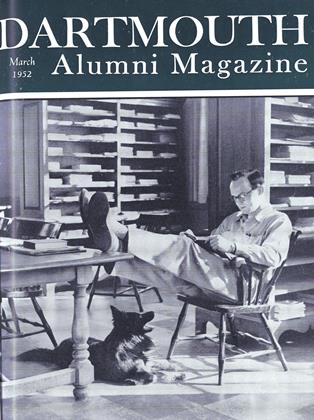Down around the Post Office and in Tanzis' townspeople are collecting in small groups to talk about the snow. Between toppling boxes of breakfast cereal and cans of soup from the shelves, Harry, Leon, and Charlie speak authoritatively about past storms—it is a time for reflection and this is a day when the word of the old timers counts.
Memory has to go back through the drifts to Easter Vacation of 1933 to match the 23 inches that fell in the "record storm" of February 17-18, 1952. The facts come from Professor-Richard H. Goddard '20, Director of Shattuck Observatory and Dartmouth's official meteorological recorder. During the more than twenty years that Dick Goddard has been recording the snows, his 36-inch snow stick has always been adequate, but this winter may yet prove it obsolete. On the evening after the storm there was, by official measurement, an accumulated depth of 34 inches on his snow table.
In a way, there is something reassuring and friendly about the storm—or rather, the effects of the storm. As in the case of flood or earthquake or hurricane, barriers are broken. When the elements are aroused we humans always draw closer together.
The Town and the College joined forces to break a few of Main Street's barriers on the weekend after the storm. Fraternity members, organized under the Interfraternity Council, helped and the Dartmouth Christian Union and many "unaffiliated" students pitched in. The mass effort was imperative because, with tons of snow lining either side of the street, parked cars projected into the driving lanes, giving the main thoroughfare the width of a back road.
By the time this copy is set in type, Hanover may be completely buried. Buried, perhaps, but not lost—saved from the fate of storied Atlantis by the weathervane atop Baker.
 View Full Issue
View Full Issue
More From This Issue
-
 Article
ArticleAround the World in Fifty Books
March 1952 By JOHN HURD '21 -
 Article
ArticleTelevision and Education
March 1952 By EDWARD LAMB '24 -
 Class Notes
Class Notes1918
March 1952 By ERNEST H. EARLEY, DONALD L. BARR, RICHARD P. WHITE -
 Class Notes
Class Notes1929
March 1952 By F. WILLIAM ANDRES, EDWIN C. CHINLUND, JACK D. GUNTHER -
 Article
ArticleThe Undergraduate Chair
March 1952 By Conrad S. Carstens '52 -
 Class Notes
Class Notes1923
March 1952 By TRUMAN T. METZEL, COLIN C. STEWART 3RD








